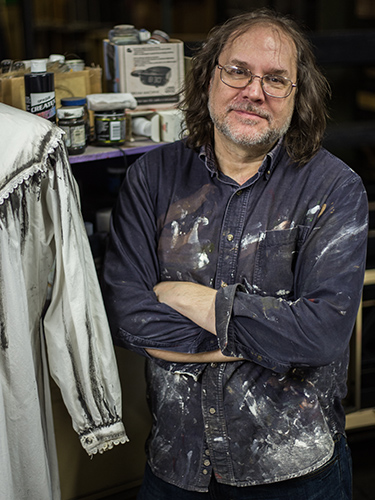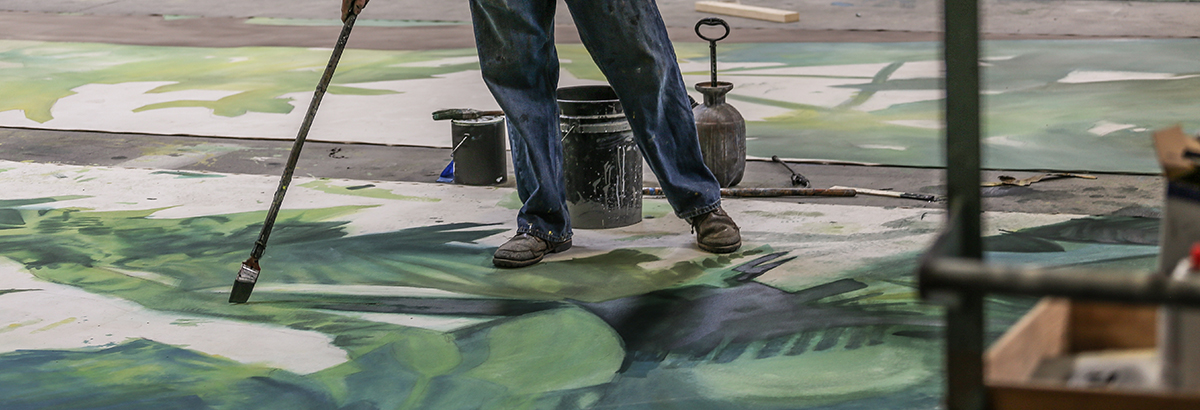April 18, 2019
Interview with Brian Traynor
Brian Traynor - Charge Artist

What is your role here at Lyric, and how long have you held the position?
I’ve been at Lyric since the 1998/99 season and I am the Charge Artist. It’s my job to make sure the finishes on the scenery, props, and costumes for a production are visually appropriate for the concept the designers and director have in mind. For instance, if we need to make rebels the for a new production of Carmen look like they’ve been in mountains for months, or soldiers in Bel Canto appear as though they’ve been in a rain forest, we have to make their clothes look lived in and dirty — or muddy if it’s raining — and ensure these pieces match the elements of the story’s narrative. Costumes, props and sets reinforce the personalities of the characters, the time period, and the location a show takes place, and we work to make sure they are consistent and accurate representations of each unique production.
What led you to work at Lyric?
In 1997, I was working for a scene shop that built a show for Lyric to be performed at Depaul’s Merle Reskin Theatre. During the rehearsal period, they needed someone to come back in and touch things up, paint props, etc. I went in for a few days and they liked the job I did. Some of the Lyric staff remembered me later on and got me an 'audition' for the Charge Artist position once it was vacant. The rest is history!
What’s a typical day like for you?
In the morning, I determine which props and scenery pieces are needed later in the day for rehearsals. The painters and I then spend time painting, re-carving, and implementing any design changes that may have come back from the director or production designers the day before. If a newly-built piece needs to look rocky, muddy, weathered, old, etc., we work to make sure it’s consistent with the design concept and blends with the existing pieces around it.
What’s the most challenging aspect of your job?
I have to come up with an answer that will solve a particular question in the time we have, with the materials available. Whether the challenge is how we can finish a new wall to look like an extension of an old cement wall, or how to help make it look real when Alberich’s arm is cut from his shoulder in Das Rheingold, I always have to be thinking on my feet and problem solving.
What keeps you committed to the work you do?
I’m very invested in making sure we have the appropriate backgrounds and set pieces in place for all of Lyric’s productions. I think it’s important the audience not be taken out of the moment. Sometimes when you’re watching a show and you see something really out of place, everything else is spoiled. But when everything on the stage looks right, then the artists can simply convey the message of the show without anything being taken away from that. Everything can be as it should, and that is very fulfilling.
What’s something about your job that people might not know?
People might be surprised to learn that most, if not everything you see on Lyric’s stage, is handcrafted. We create hand-made product in a machine-made world. Everything is custom-made for a particular show, such as the cakes and desserts in our new Magic Flute and last season’s The Marriage of Figaro or the portraits in the background of Tosca (2004/05 season).
Favorite Lyric moment?
Being backstage for the death scene in Madame Butterfly during Lyrics 2003/04 season. The title role was sung by Sylvie Valayre, and she was spectacular. I’d been told the scene was really beautiful, and I happened to be backstage during one of the performances. I looked over and in the wings, there was a line of stage hands and cast members just watching in awe. That’s when you can tell something is really special.
Beyond opera, what are your other passions?
I love collecting things drawn from the hands of designers like renderings, sketches, blueprints for buildings, furniture, jewelry, and stage designs. I’m always interested in how each designer conveys their ideas to the fabricators through their drawings so pieces that exist only in their minds can be made into something tangible.
